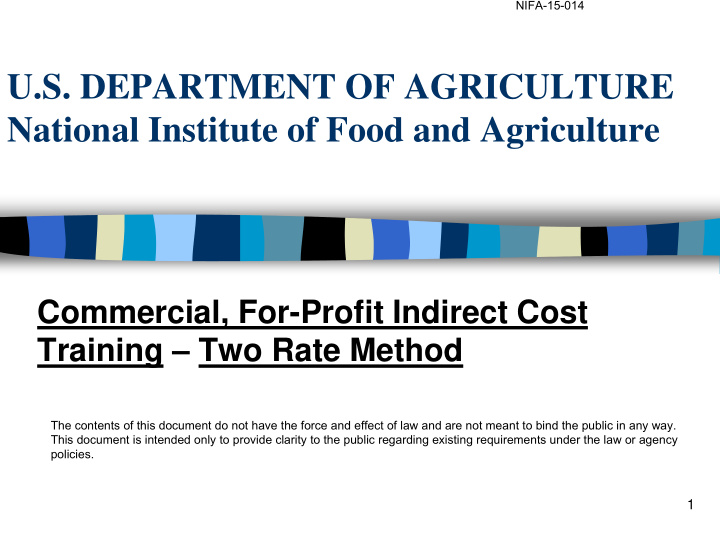



NIFA-15-014 U.S. DEPARTMENT OF AGRICULTURE National Institute of Food and Agriculture Commercial, For-Profit Indirect Cost Training – Two Rate Method The contents of this document do not have the force and effect of law and are not meant to bind the public in any way. This document is intended only to provide clarity to the public regarding existing requirements under the law or agency policies. 1
Similarities to the One Rate Method: Same 3 definitions relevant to ICRs + fringe benefits Same 3 steps to calculate an ICR ( 1 obtain expenses, 2 classify expenses, 3 calculate rates (F/B rate and ICR), but 3 rd step is now done in 3 parts Same 3 ways to check the grant budget 2
Differences from the One Rate Method: Two rates instead of one rate (indirect cost rate and a fringe benefit rate) Fringe benefits (employee benefits) are not included in the ICR, but rather broken out separately in their own rate Fringe benefits can now appear as a direct cost in the grant budget Step 3 is done in 3 parts: 3a calculate F/B rate; 3b assign F/B’s to indirect and direct columns; 3c calculate ICR 3
What are Fringe Benefits (F/B)? Allowances and services that employers provide to employees – Paid absences (vacation, sick, holiday) – accounted for on hourly timesheets w/ labor charges. – Payroll taxes – Pension plan costs – Group insurance (health, life, disability) 4
How to Calculate a Fringe Benefit Rate Pool (numerator) = fringe benefits (paid abs, payroll taxes, pension and insurance) Base (denominator) = total salaries (direct and indirect) Do a sample two-rate method (ICR and fringe benefit rate) and check your answer Review the grantees proposed budget and check your answer 5
Recommend
More recommend